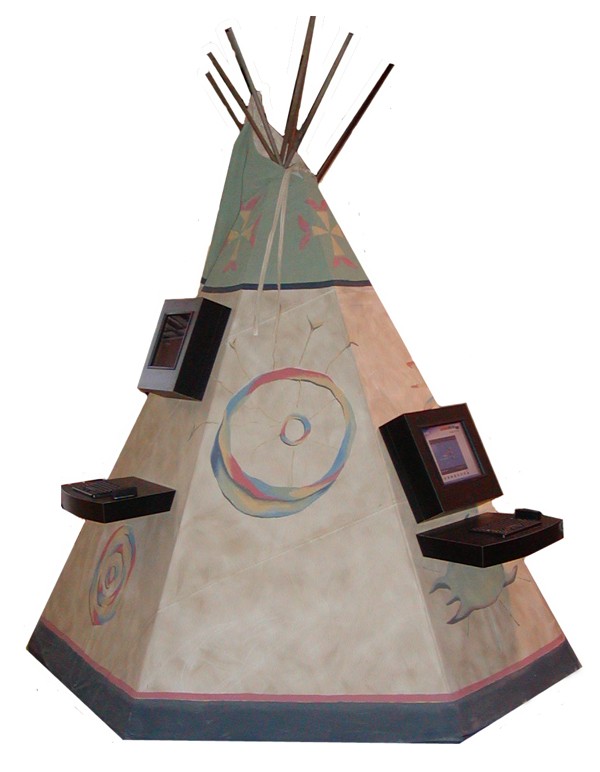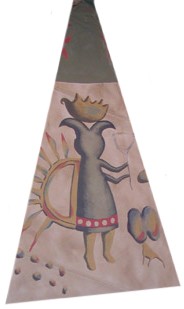Article
Native Americans strike up the kiosk
American Indian entrepreneur, North Carolina company team to sell Native American art using a tepee-shaped kiosk.
February 18, 2002
For American Indian Mall LLC founder David Smoot, the idea of providing a new outlet for Native American art was a family thing.
"My sister (Linda Windell) is an artist and it was tough watching her come up with the money to buy her prints in order to sell enough to make and earn a living," Smoot said. "I thought there had to be a better way and we finally figured one out."
What Smoot came up with was an electronic kiosk with a link to his company's Web site. Customers can browse the site, make their selections, and order.
But it is the design of the kiosk - a tepee - that attracts the most attention. Built with poles sturdy enough to handle the enclosure of three computer units and monitors, the tepee nonetheless is designed and built in the traditional manner of a Native American tepee.
And the company's initial tepee kiosk is finding maximum exposure courtesy of the Winter Olympics in Salt Lake City, Utah. The kiosk is located in downtown Salt Lake City near the Delta Center arena alongside a pavilion called "Discover Navajo 2002 - People of the Fourth World."
The Olympics is giving Smoot's company and Native American art instant exposure before a worldwide audience. And that has the entrepreneur thinking on a global scale.
"The kiosk is more or less a marketing tool and a place to purchase the art," he said. "Our store front will be available all around the world, and we'll put tepee kiosks everywhere we can put it."
The artistic process
A half Creek Indian born in Oklahoma and raised in an orphanage in Ohio between the ages of nine and 16, Smoot has been involved in sales and marketing and worked for a computer company in California before launching American Indian Mall last year.
Creating a kiosk to promote and sell the products on Smoot's Web site appealed to him because of the possibility of reaching a wider audience.
"It's just a great way for the artist to increase their exposure," he said. "Perhaps one percent of the potential market out there knows about the work. That leaves 99 percent of the market to go find it. We'll increase the exposure and also increase their revenue. The better they become known, the better they'll be treated."
 |
Meridian Kiosks worked with American Indian Mall LLC to integrate computer units with the tepee and its art work. |
About 50 Native American artists showcase their work on the Web site. The work, grouped by artist and by theme (warriors, traditional attire, ceremony, etc.), is reproduced in a variety of formats, from 11-inch by 14-inch poster art to canvas renderings. The art generally sells anywhere from between $50 and $350.
Under the deal Smoot has with the artists, each artist receives 10 percent of the revenue from each print sold. Roughly 60 percent is absorbed in printing expenses and another 10 percent for shipping and handling. Smoot donates 5 percent of the net profits to American Indian youth programs.
Smoot said he eventually expects competition, but believes his relationships with the artists will strengthen his grip on the market.
"I think people will start copying us, but if we keep together our stable of artists and treat them right, the bar of entry will be quite difficult," he said.
Rapid development
The challenge for Smoot and Meridian Kiosks Inc., which developed the kiosks, was getting the tepee to the Olympics.
Smoot had the concept and the Navajo nation, through its exhibition space at the Olympics, provided the platform. All Smoot needed was the kiosk itself.
"Dave contacted us through our Web site. He saw we'd done some unique kiosks, some atypical things. So we put some drawings together for him and the application needs," Dave Petsolt, Meridian Kiosks co-founder, said in early February.
 |
Authentic Native American art work was utilized for the tepee kiosk. |
"It was about three weeks ago he contacted us and said go," he continued. "At that stage we just had the drawings. We had the concept and we had to hire the artists to do the drawings and authenticate it. Dave got the place (in Salt Lake City) and we dropped it off (in late January)."
The kiosk, apart from requiring stronger wooden poles needed to balance the tepee and the computer units, has an authentic feel thanks to indigenous drawings of deer, snakes, and various designs. Each computer's processing unit is contained within the tepee, with only the monitor and a keyboard/track ball appearing externally. The tepee itself is made collapsible by removing the computer units.
"They were great people to work with," Smoot said of Meridian. "They really busted their humps getting it there on time."
Added Petsolt: "It was a fun project. They expect an enormous amount of traffic which will help push sales of the artwork which is great."
The Olympics and beyond
The project, Smoot admitted, has cost his company a certain amount of wampum. He said a tepee kiosk mounted against a wall with two computers costs about $20,000, and an in-the-round kiosk, with three units, costs roughly double that amount.
For the privately owned American Indian Mall, fiscal soundness is crucial in the company's early days.
"We've been funded to a little under $500,000," Smoot said. "We've spent about half that to get (to the Olympics). There's way to gain some additional funding. We'll have a sponsor or two from tribes."
The Web site and kiosk have gotten off to a fast start, according to Smoot. The site generated 85,000 hits in its first 11 days online, while the kiosk has attracted press attention and customers, including noted golfer and television analyst Johnny Miller.
If the Olympics continue to go well, Smoot plans to take the kiosk on the road to other Navajo art exhibits. He also is talking to shopping malls about deploying tepee kiosks in retail centers. For right now, the focus is on surviving the Olympics, and making sure American Indian art receives as much exposure as possible while it is on the world's stage.







